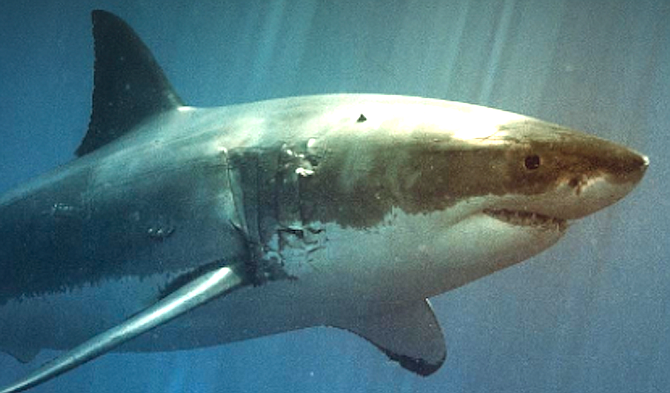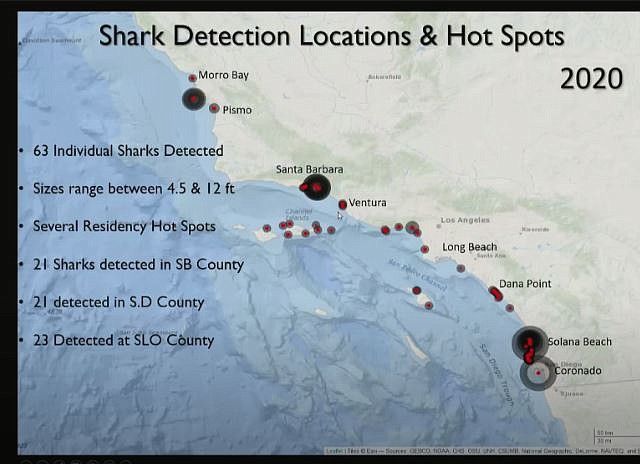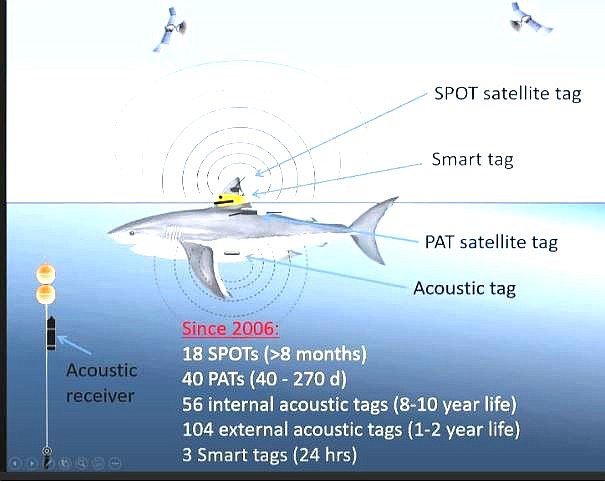 Facebook
Facebook
 X
X
 Instagram
Instagram
 TikTok
TikTok
 Youtube
Youtube

As summer nears, sharks are on the move. And so are people, packed like sardines on beaches and in the water where sometimes, a large predatory fish swims right below, unnoticed.
Over the last five years, California lifeguards have reported a five-fold increase in great white shark sightings.
From April through October, Southern California is their nursery, and San Diego has become a hotspot, according to Chris Lowe, professor in marine biology and director of the Cal State Long Beach Shark Lab.
"We clearly have an aggregate of great white sharks off Del Mar," Lowe told the Del Mar City Council on May 3. Lowe's team is tagging and tracking white sharks, using drones and other technology that will help yield better alert systems.
"One of our top goals is to be able to predict where and when young white sharks will show up at a beach," he says in an email.
That hasn't been easy, as mystery shrouds the creature's movements.
"We don’t know how large the population of white sharks off California used to be or how large it is now, in total. We just have some new data suggesting it’s increasing based on fisheries bycatch data, shark sightings, marine mammal bites, and some very limited population studies."
While he says there is no population estimate for Del Mar, "we have seen at least seven different sharks at one time in one area less than the size of a football field. There could be as many as 30 juvenile white sharks in the Del Mar/ Solana Beach area."

California and Northeast Pacific area population estimates range from 1000 – 3000 white sharks, but even those estimates may not be very accurate.
Water safety officials need the kind of data Lowe's work is developing. Tagging is done by drone or helicopter, darting a tag in the fish's back. If they catch a shark, they can use acoustic receivers for tracking. Underwater receivers are used off Del Mar.
The entire acoustic receiver array, stretching from Morro Bay to Coronado, takes a crew a month to download.
One thing they've learned is that the hotspots where the sharks hang out have changed over the years. In 2015, it was Long Beach. In 2017, Dana Point. Tagging in 2019-2020 revealed a big uptick had occurred in Santa Barbara and San Diego.

"We think they like our beaches." It's safe for the youngsters; there's a good supply of one of their staple foods, stingrays; and the water is warmer.
But the shift may not last. "We just published a study showing that nursery areas for white sharks are moving northward, off Monterey and Santa Cruz," likely due to the growing population and climate change.
Four new real-time receiver buoys will provide alerts of tagged sharks, data only lifeguards can access. Drone surveys will help the scientists track an aggregate, and find out why it's at a particular beach.
A cell phone app, still in the works, will eventually let anyone report sightings. "That database would be really helpful."
The team is also teaching lifeguards how to spot aggressive behavior. Policy is being developed for when to post signs. As sharks move into heavily populated areas, Lowe said the cost of beach closures add up. The short term economic impacts on communities can be "pretty significant."
Another goal is to learn more about white shark behavior so they can teach people how to be safer in the water with them.
Of all water users, surfers and paddle boarders have been found the most likely to encounter a shark. Bumping behavior, a common complaint, isn't always intentional. The shark may swim right under a surfer, get startled, and whack the board with its tail.
"Occasionally we think they're just curious."
Compared to the number of sharks now in the waters, bites are "amazingly low."
It's another mystery.
"The whole reason why sharks bite people is simply unknown." Even the wetsuit-resembles-seal theory is just a theory. Since sharks are colorblind, wetsuit color isn't as important as silhouette. Avoiding murky water and traveling in groups are among Lowe's safety tips.
A sign of aggression is when sharks are moving quickly, and taking off at high speed. If you're on a board, aim it towards the shark, which will see the head as a potential threat and take off.
"Let the shark know you see it."


As summer nears, sharks are on the move. And so are people, packed like sardines on beaches and in the water where sometimes, a large predatory fish swims right below, unnoticed.
Over the last five years, California lifeguards have reported a five-fold increase in great white shark sightings.
From April through October, Southern California is their nursery, and San Diego has become a hotspot, according to Chris Lowe, professor in marine biology and director of the Cal State Long Beach Shark Lab.
"We clearly have an aggregate of great white sharks off Del Mar," Lowe told the Del Mar City Council on May 3. Lowe's team is tagging and tracking white sharks, using drones and other technology that will help yield better alert systems.
"One of our top goals is to be able to predict where and when young white sharks will show up at a beach," he says in an email.
That hasn't been easy, as mystery shrouds the creature's movements.
"We don’t know how large the population of white sharks off California used to be or how large it is now, in total. We just have some new data suggesting it’s increasing based on fisheries bycatch data, shark sightings, marine mammal bites, and some very limited population studies."
While he says there is no population estimate for Del Mar, "we have seen at least seven different sharks at one time in one area less than the size of a football field. There could be as many as 30 juvenile white sharks in the Del Mar/ Solana Beach area."

California and Northeast Pacific area population estimates range from 1000 – 3000 white sharks, but even those estimates may not be very accurate.
Water safety officials need the kind of data Lowe's work is developing. Tagging is done by drone or helicopter, darting a tag in the fish's back. If they catch a shark, they can use acoustic receivers for tracking. Underwater receivers are used off Del Mar.
The entire acoustic receiver array, stretching from Morro Bay to Coronado, takes a crew a month to download.
One thing they've learned is that the hotspots where the sharks hang out have changed over the years. In 2015, it was Long Beach. In 2017, Dana Point. Tagging in 2019-2020 revealed a big uptick had occurred in Santa Barbara and San Diego.

"We think they like our beaches." It's safe for the youngsters; there's a good supply of one of their staple foods, stingrays; and the water is warmer.
But the shift may not last. "We just published a study showing that nursery areas for white sharks are moving northward, off Monterey and Santa Cruz," likely due to the growing population and climate change.
Four new real-time receiver buoys will provide alerts of tagged sharks, data only lifeguards can access. Drone surveys will help the scientists track an aggregate, and find out why it's at a particular beach.
A cell phone app, still in the works, will eventually let anyone report sightings. "That database would be really helpful."
The team is also teaching lifeguards how to spot aggressive behavior. Policy is being developed for when to post signs. As sharks move into heavily populated areas, Lowe said the cost of beach closures add up. The short term economic impacts on communities can be "pretty significant."
Another goal is to learn more about white shark behavior so they can teach people how to be safer in the water with them.
Of all water users, surfers and paddle boarders have been found the most likely to encounter a shark. Bumping behavior, a common complaint, isn't always intentional. The shark may swim right under a surfer, get startled, and whack the board with its tail.
"Occasionally we think they're just curious."
Compared to the number of sharks now in the waters, bites are "amazingly low."
It's another mystery.
"The whole reason why sharks bite people is simply unknown." Even the wetsuit-resembles-seal theory is just a theory. Since sharks are colorblind, wetsuit color isn't as important as silhouette. Avoiding murky water and traveling in groups are among Lowe's safety tips.
A sign of aggression is when sharks are moving quickly, and taking off at high speed. If you're on a board, aim it towards the shark, which will see the head as a potential threat and take off.
"Let the shark know you see it."
Comments